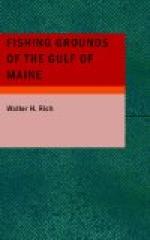PREFACE TO THE 1994 EDITION
Fishing Grounds of the Gulf of Maine by Walter H. Rich first appeared in the U.S. Department of Commerce, Bureau of Fisheries, Report of the United States Commissioner of Fisheries, for the fiscal year 1929.
When Captain Robert McLellan of Boothbay Harbor died in 1981, the employees of the Maine Department of Marine Resources contributed money to be used to purchase books in his memory, for the Department’s Fishermen’s Library. Captain McLellan’s family was asked what purchases they would recommend, and a top priority was to somehow reprint this work on the fishing grounds. This was a book that had been helpful to Captain McLellan in his career, and one which his son, Captain Richard McLellan, found still valid and useful.
Contributions from the employees of the Department of Marine Resources paid to get this project started; film to reproduce the pages of the original text was donated by the Bigelow Laboratory for Ocean Sciences; printing costs were paid by the Department.
It is the hope of the Department and its employees that the fishermen of today will benefit from the detailed information in this publication, and that they will remember Captain Robert McLellan, a man who knew how to use books to enhance his career as a fisherman, who knew how to share his knowledge with the scientific community, and who was widely respected by fishermen and scientists alike.
INTRODUCTION
Paralleling the northeastern coast line of North America lies a long chain of fishing banks—a series of plateaus and ridges rising from the ocean bed to make comparatively shallow soundings. From very early times these grounds have been known to and visited by the adventurers of the nations of western Europe—Northman, Breton, Basque, Portuguese, Spaniard, Frenchman, and Englishman. For centuries these fishing areas have played a large part in feeding the nations bordering upon the Western Ocean, and the development of their resources has been a great factor in the exploration of the New World.
According to statistics collected by the Bureau of Fisheries.[2] these banks annually produce over 400,000,000 pounds of fishery products, which are landed in the United States; and, according to O. E. Sette,[3] annually about 1,000,000,000 pounds of cod are taken on these banks and landed in the United States, Canada, Newfoundland, France, and Portugal.
Apparently the earliest known and certainly the most extensive of these is the Great Bank of Newfoundland, so named from time immemorial. From the Flemish Cap, in 44 deg. 06’ west longitude and 47 deg. north latitude, marking the easternmost point of this great area, extends the Grand Bank westward and southwestward over about 600 miles of length. Thence, other grounds continue the chain, passing along through the Green Bank, St. Peters Bank, Western Bank (made up of several more or less connected grounds, such as Misaine Bank, Banquereau, The Gully, and Sable Island Bank); thence southwest through Emerald Bank, Sambro, Roseway, La Have, Seal Island Ground, Browns Bank, and Georges Bank with its southwestern extension of Nantucket Shoals.




